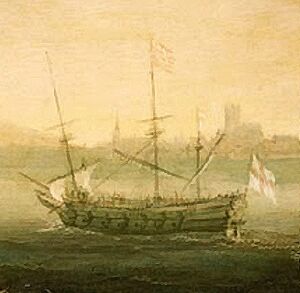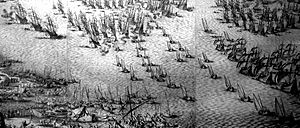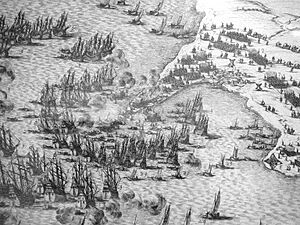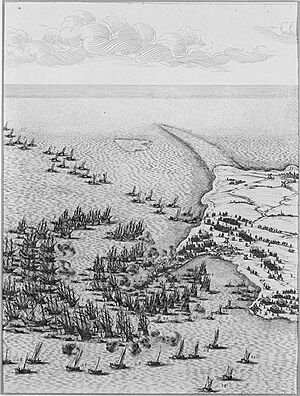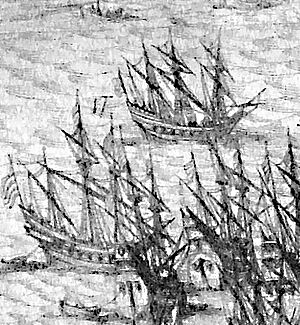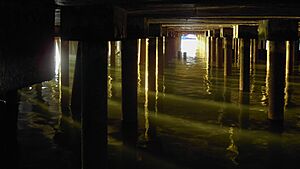Lyon's Whelp facts for kids
The Lyon's Whelp (or Lion's Whelp) is a famous name for British ships from history. It's even mentioned in the Bible! This name was very popular in the 1500s for naval ships. Later, in the 1600s, it was given to a group of ten fast warships called pinnaces. These ships were ordered by a very powerful person named George Villiers, the first Duke of Buckingham.

A ship from the time of Charles I of England, before 1649
|
|
Quick facts for kids History |
|
|---|---|
| Name | Lion's Whelp |
| Ordered | 28 February 1628 |
| Laid down | March 1628 |
| Launched | late July, 1628 |
| Acquired | Duke of Buckingham, July, 1628; Royal Navy, 1632 |
| Commissioned | 1632 |
| In service | 1628 to 1632 to 1654 |
| Out of service | 1628 to 1632 to 1654 |
| Fate | Various |
| Notes | John Graves built eighth and ninth Whelps. Phineas Pett's certificates of works done have survived for all Whelps except the ninth. |
| General characteristics | |
| Type | 3-masted pinnace, auxiliary oared warship |
| Displacement | 186 tons 180 long tons (183 t) |
| Beam | 25 ft (7.6 m) |
| Depth of hold | 9 ft (2.7 m) |
| Propulsion | Sweeps (two oars between each cannon port). |
| Armament | 9 broadside cannons, 2 sternchase gunports |
| Notes | The Whelps were classed as ships "of the sixth rank" |
Contents
The Lion's Whelp Fleet
The ten Lion's Whelp ships built by the Duke of Buckingham in 1628 were excellent examples of 'war pinnaces'. A pinnace was a type of warship used by many European navies for over 200 years. These ships had both sails and oars, which made them very versatile.
Countries like England, the Netherlands, Sweden, and Poland regularly used war pinnaces. The biggest ones were similar to England's smaller warships, known as fifth rate and sixth rate ships. War pinnaces were fast and easy to steer compared to larger warships. If they had a skilled captain and a disciplined crew, they could achieve impressive results in battles and spying missions.
Building Buckingham's Fleet
The Duke of Buckingham paid for all ten Lion's Whelp ships himself, even though they were armed and supplied by the Royal Navy. The whole fleet cost him about £7,000 in 1628. This was a huge amount of money at the time, showing how wealthy he was. For several years, these ships were his own private fleet.
Under the Duke's command, the Lion's Whelps acted as privateers. This meant they were private ships allowed to attack enemy ships and take their goods, which helped increase the Duke's personal wealth. The Royal Navy didn't take over the fleet until 1632, after the Duke was assassinated in 1628. His family was paid at least £4,000 for the ships.
Earlier Lion's Whelp Ships
The name Lyon's Whelp was used for several British naval ships even before the Duke of Buckingham's fleet. At least two of these earlier ships were not paid for or built by him. One important ship named Lion's Whelp belonged to Charles Howard, 1st Earl of Nottingham. He was the top admiral of England before the Duke of Buckingham.
This Lion's Whelp was lent to Sir Walter Raleigh and joined the English fleet in 1596. They took part in a combined attack with the Dutch to capture Cadiz in Spain. The English and Dutch quickly won, and they looted Cadiz. This Lion's Whelp was later sold to the state in 1602. It was repaired by a skilled shipbuilder named Phineas Pett. In 1625, King James VI gave this ship as a gift to the Duke of Buckingham.
Ship Design and Construction
Historians have studied old documents to learn about the ten Lion's Whelps built by the Duke of Buckingham. Each Whelp had one gun deck and two masts with both square and lateen sails. There are not many drawings of English warships from that time. So, details about their design often come from Dutch Navy ship plans and paintings.
The Duke of Buckingham's plan to build these ships started with his friends, Captain Sir John Penington and Phineas Pett. They made sure the best shipbuilders were available. The ships were designed to be warships of about 125 tons, using both sails and oars. They were built along the River Thames. The goal was to add these ten ships to the English fleet to help in the siege of La Rochelle. This was a major event where King Louis XIII of France was attacking the French Protestants (called Huguenots).
The Anglo-French War and the Whelps
At least one of Buckingham's ten Lion's Whelps served with the British Fleet during the Anglo-French War. England tried to help the Huguenots in La Rochelle. The English action started with a siege of the Saint-Martin-de-Re fortress in 1627. The English fleet couldn't attack La Rochelle directly until months later.
An artist named Jacques Callot created prints showing the English landing on the Isle de Re and the sieges. His detailed prints allow us to see different types of ships in the English fleet, including pinnaces. It's possible that one of the pinnaces in these prints is Buckingham's sixth Lion's Whelp.
Buckingham's Leadership
King James I gave his favorite, the Duke of Buckingham, a very important role in the mission to help La Rochelle. England hoped that a victory would make the French Protestants allies against Catholic Spain. It would also show off England's naval power. However, the Duke of Buckingham showed he lacked experience in leading both army and navy challenges.
The siege of Saint-Martin-de-Re was the first part of the attempt to take La Rochelle. It began when Buckingham's fleet landed troops on the beach. Buckingham insisted on organizing his army slowly on the open beach. Meanwhile, French troops attacked repeatedly from the sand dunes. About 100 English soldiers were needlessly killed on the beach. Later, it was found that the ladders Buckingham brought for the siege were too short to reach the fortress walls.
England's plan was to capture Saint-Martin-de-Re first, as it was a big obstacle to attacking La Rochelle. But with 80 ships and 7,000 men, Buckingham failed to take the fortress. After three months and a final failed attack, he ended the siege. He returned to England with only 2,000 demoralized and sick men left from his original army.
A Lion's Whelp Sails to America
In 1629, a ship named Lion's Whelp sailed from Gravesend, England, to the Massachusetts Bay Colony in America. It arrived on June 30, 1629, and was greeted by Governor John Endecott. This ship was an armed merchant ship, meaning it carried goods and people but also had cannons for protection. It had eight cannons, similar to the Duke of Buckingham's Lion's Whelps.
However, this Lion's Whelp was likely not one of Buckingham's fleet. It is believed to be a 120-ton ship that carried settlers like William Dodge and the Sprague family to Salem, Massachusetts. It was part of a small fleet of six ships, including the Talbot, George Bonaventure, Lyon, and a ship called Mayflower (but not the famous Mayflower of the Pilgrims). This Lion's Whelp brought supplies and new settlers to the area known as Naumkaeg, which became Salem.
The Fate of the Ten Lion's Whelps
After the Duke of Buckingham was assassinated in 1632, his fleet of ten Lion's Whelps was taken into the Royal Navy. His family was paid £4,500 for them. Here's a brief look at what happened to some of them:
- The first Lion's Whelp' was built by William Castell. It was later turned into a "chain ship" to block rivers and was eventually sold around 1651.
- The second Lion's Whelp' was also built by William Castell. It became a chain ship too and was ordered to be sold in 1650 because it was too old and decayed.
- The third Lion's Whelp' was built by John Dearsley. It was deemed unfit for service by 1647 and removed from the fleet.
- The fourth Lion's Whelp' was built by Christopher Malim. It sank in St. Aubrey's Bay, Jersey, on August 4, 1636, after hitting a rock. Luckily, no lives were lost.
- The fifth Lion's Whelp' was built by Peter Marsh. It spent most of its time serving in Ireland. It sank in the North Sea on June 28, 1637, and 17 men died. The ship was built with poor quality wood.
- The sixth Lion's Whelp' was built by Peter Pett, a famous shipwright. Its captain was John Pett, son of the great shipbuilder Phineas Pett. Sadly, this ship sank off the coast of Brittany in 1628 while returning from the La Rochelle expedition, and Captain John Pett died.
- The seventh Lion's Whelp' was built by Matthew Graves. It was destroyed by a huge explosion in its powder store during a dispute with a Dutch warship.
- The eighth Lion's Whelp' was built by John Graves. It was used to transport gold to the Scottish parliament in 1644. By July 1645, it was too decayed to repair and was laid up.
- The ninth Lion's Whelp' was also built by John Graves. It served in Ireland, mainly fighting piracy. It became a wreck in the River Clyde in April 1640 while carrying supplies.
- The tenth Lion's Whelp' was built by Robert Tranckmore. It joined the Royalists during the English Civil War but was recaptured by Parliament's forces. It was later used as a fireship and for convoy work. The last mention of it is in 1654 when it was sold.
With the sale of the tenth Lion's Whelp, this fleet disappears from recorded history. Their stories have helped us learn more about how small warships were built in the 1600s and about the activities of the Royal Navy during the Anglo-French War.


